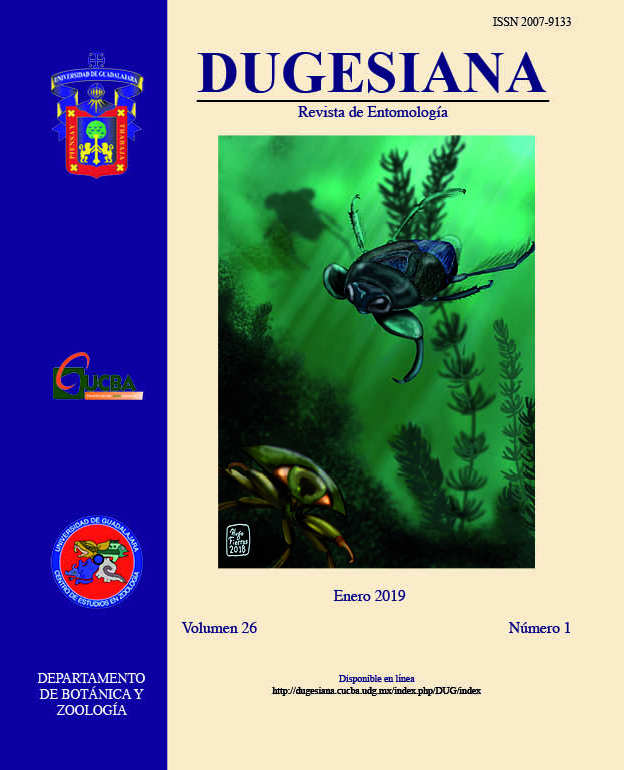Escarabajos descortezadores y ambrosiales (Coleoptera: Curculionidae: Scolytinae, Platypodinae) de Sonora, México
DOI:
https://doi.org/10.32870/dugesiana.v26i1.7068Keywords:
desierto sonorense, selva baja tropical, Sierra Madre Occidental, asociaciones con plantas hospederasAbstract
Con base a trabajo de campo reciente y revisión de ejemplares en museos se conocen 70 especies de escarabajos descortezadores y ambrosiales en el estado de Sonora. De estas, 43 se reportan por primera vez del estado. Especies sociadas a bosques templados de montaña (pinos y encinos) formaban el grupo más diverso con 30 especies, seguido por las de bosques tropicales secos con 23especies. En ambos grupos las especies incluidas tienen distribuciones más amplias fuera de la región. Hubo 15 especies asociadas a comunidades desérticas y matorrales, 9 de las cuales se pueden considerar endémicas al Desierto Sonorense. Dos especies exóticas están asociadas a ecosistemas dominados por humanos. Independiente de la comunidad biótica, casi todas las especies encontradas eran fleófagas y especialistas respecto a hospederas.References
Alonzo-Zarazaga, M.A. y C.H.C. Lyall. 2009. A catalogue of family and genus group names in Scolytinae and Platypodinae with nomenclatorial remarks (Coleoptera: Curculionidae). Zootaxa, 2258: 1–134. http://www.mapress.com/zootaxa/list/2009/zt02258.html
Armendariz, F.; y G. Zúñiga. 2016. Illustrated Key to Species of Genus Dendroctonus (Coleoptera: Curculionidae) Occurring in Mexico and Central America. Journal of Insect Science, 34: 1–15. https://doi.org/10.1093/jisesa/iex009
Atkinson, T.H. 2010. New species and records of Cactopinus Schwarz with a key to species (Coleoptera: Curculionidae: Scolytinae). ZooKeys 56:13-33. https://doi.org/10.3897/zookeys.56.515
Atkinson, T.H. 2017. Curculionidae: Scolytinae: Escarabajos Descortezadores y Escarabajos Ambrosiales. (pp. 306–313) En Cibrián T., D. (Ed.) Fundamentos de Entomología Forestal. CONACYT, Mexico.
Atkinson, T.H. 2018. http://www.barkbeetles.info. Fecha de consulta: 1 de mayo, 2018.
Atkinson, T. H. y A. Equihua M. 1988. Notas sobre biología y distribución de Scolytidae y Platypodidae de México y Centroamérica [Notes on biology and distribution of Scolytidae and Platypodidae from Mexico and Central America]. Folia Entomológica Mexicana, 76: 83–105.
Atkinson, T.H y A. Equihua. 1986a. Biology of Scolytidae and Platypodidae (Coleoptera) of a tropical rain forest in southeastern Mexico with an annotated checklist of species. Annals of the Entomological Society of America, 79: 414–423. https://doi.org/10.1093/aesa/79.3.414
Atkinson, T.H y A. Equihua. 1986b. Biology of the Scolytidae and Platypodidae (Coleoptera) in a tropical deciduous forest at Chamela, Jalisco, Mexico. Florida Entomologist, 69(2): 303–310. http://journals.fcla.edu/flaent/article/view/58147
Bright, D.E. 1981. Taxonomic monograph of the genus Pityophthorus Eichhoff in North and Central America (Coleoptera: Scolytidae). Memoirs of the Entomological Society of Canada, 118: 1 – 378. https://doi.org/10.4039/entm113118fv
Bright, D.E. y R.E. Skidmore. 2002. A Catalog of Scolytidae and Platypodidae (Coleoptera), Supplement 2 (1995-1999). NRC Research Press, Ottawa, Canada.
Brown, D.E., F. Reichenbacher y S.E. Franson. 1998. A classification of the North American biotic communities. University of Utah Press, Salt Lake City, Utah.
Brown, D.E., P.J. Unmack, y T.C. Brennan. 2018. Biotic Communities of North America. website http://www.peter.unmack.net/biotic/. Fecha de consulta: 12 de febrero 2018.
Garrick, R.C., J.D. Nason, J.F. Fernandez y R.J. Dyer. 2013. Ecological coassociations influence species’ responses to past climatic change: an example from a Sonoran Desert bark beetle. Molecular Ecology, 22: 3345–3361. https://doi.org/10.1111/mec.12318
Johnson, A.J., M. Knížek, T.H. Atkinson, B.H. Jordal, R.C. Ploetz y J. Hulcr. 2017. Resolution of a global mango and fig pest identity crisis. Insect Systematics and Diversity, 1(2): 1– 10. https://doi.org/10.1093/isd/ixx010
Noguera M., F.A., y T.H. Atkinson. 1990. Biogeography and biology of bark and ambrosia beetles (Coleoptera: Scolytidae and Platypodidae) in a mesic montane forest in Mexico with an annotated checklist of species. Annals of the Entomological Society of America, 83(3): 453–466. https://doi.org/10.1093/aesa/83.3.453
Wood, S.L. 1982. The bark and ambrosia beetles of North and Central America (Coleoptera: Scolytidae), a taxonomic monograph. Great Basin Naturalist Memoirs 6: 1–1356.
Published
Issue
Section
License
1. Proposed policy for open access journals
Those authors who have publications with this journal, accept the following terms:
- The authors will retain their copyright and will guarantee to the journal the right of first publication of their work, which will be simultaneously subject to the Creative Commons Recognition License, which allows third parties to share the work whenever their author is indicated and His first publication is this journal.
- Authors may adopt other non-exclusive license agreements to distribute the version of the published work (eg to be deposited in an institutional telematic file or published in a monographic volume) provided the initial publication is indicated in this journal .
Authors are encouraged and encouraged to disseminate their work through the Internet (eg in institutional telematic files or on their web page) before and during the sending process, which can produce interesting exchanges and increase appointments Of the published work. (See The effect of open access).
2. Proposed policy for journals that offer open deferred access
Those authors who have publications with this journal, accept the following terms:
- The authors will retain their copyrights and will guarantee to the journal the right of first publication of their work [SPECIFY PERIOD OF TIME], which will be simultaneously subject to the Creative Commons Recognition License that allows third parties to share the work always That its author and his first publication be indicated this journal.
- Authors may adopt other non-exclusive license agreements to distribute the version of the published work (eg to be deposited in an institutional telematic file or published in a monographic volume) provided the initial publication is indicated in this journal .
- Authors are encouraged and encouraged to disseminate their work through the Internet (eg in institutional telematic files or on their web page) before and during the sending process, which can produce interesting exchanges and increase appointments Of the published work. (See The effect of open access).




